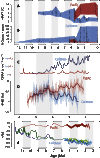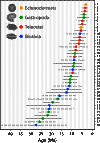Formation of the Isthmus of Panama
- PMID: 27540590
- PMCID: PMC4988774
- DOI: 10.1126/sciadv.1600883
Formation of the Isthmus of Panama
Abstract
The formation of the Isthmus of Panama stands as one of the greatest natural events of the Cenozoic, driving profound biotic transformations on land and in the oceans. Some recent studies suggest that the Isthmus formed many millions of years earlier than the widely recognized age of approximately 3 million years ago (Ma), a result that if true would revolutionize our understanding of environmental, ecological, and evolutionary change across the Americas. To bring clarity to the question of when the Isthmus of Panama formed, we provide an exhaustive review and reanalysis of geological, paleontological, and molecular records. These independent lines of evidence converge upon a cohesive narrative of gradually emerging land and constricting seaways, with formation of the Isthmus of Panama sensu stricto around 2.8 Ma. The evidence used to support an older isthmus is inconclusive, and we caution against the uncritical acceptance of an isthmus before the Pliocene.
Keywords: Central America; Evolution; GABI; Isthmian closure; ecology; land-bridge.
Figures





Comment in
-
Comment (2) on "Formation of the Isthmus of Panama" by O'Dea et al.Sci Adv. 2017 Jun 14;3(6):e1602320. doi: 10.1126/sciadv.1602320. eCollection 2017 Jun. Sci Adv. 2017. PMID: 28630902 Free PMC article.
-
Comment (1) on "Formation of the Isthmus of Panama" by O'Dea et al.Sci Adv. 2017 Jun 14;3(6):e1602321. doi: 10.1126/sciadv.1602321. eCollection 2017 Jun. Sci Adv. 2017. PMID: 28630903 Free PMC article.
References
-
- Günther A., On the fishes of the states of Central America, founded upon specimens collected in fresh and marine waters of various parts of that country by Messrs. Salvin and Godman and Capt. J. M. Dow. Proc. Zool. Soc. Lond. 1866, 600–604 (1867).
-
- Lessios H. A., The great American schism: Divergence of marine organisms after the rise of the Central American Isthmus. Annu. Rev. Ecol. Evol. Syst. 39, 63–91 (2008).
-
- Knowlton N., Weigt L. A., New dates and new rates for divergence across the Isthmus of Panama. Proc. Biol. Sci. 265, 2257 (1998).
-
- G. G. Simpson, Splendid Isolation: The Curious History of South American Mammals (Yale Univ. Press, New Haven, 1980), pp. 266.
Publication types
MeSH terms
LinkOut - more resources
Full Text Sources
Other Literature Sources

